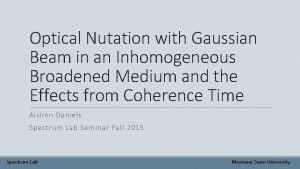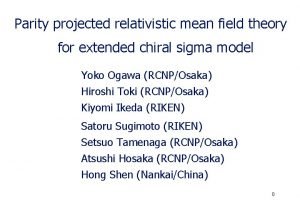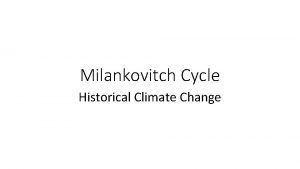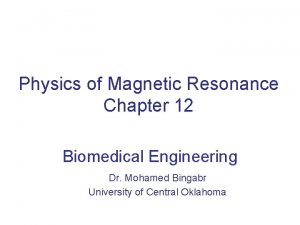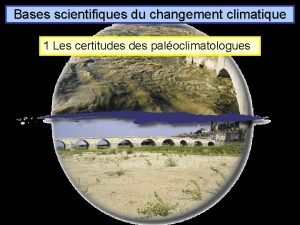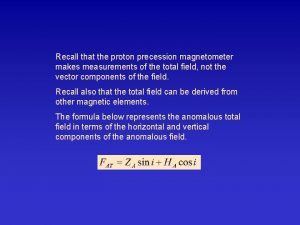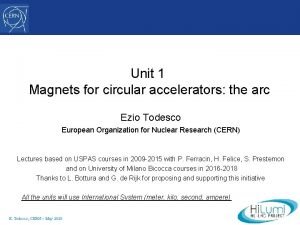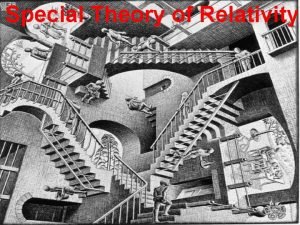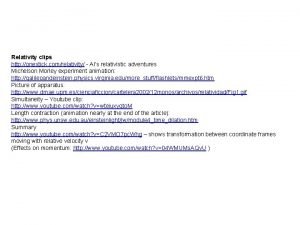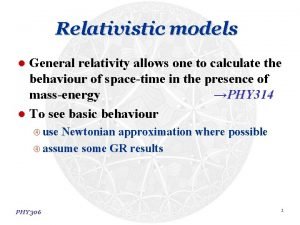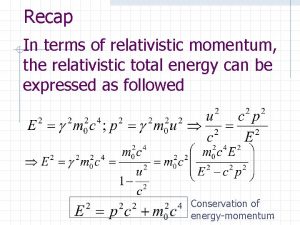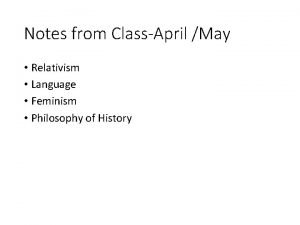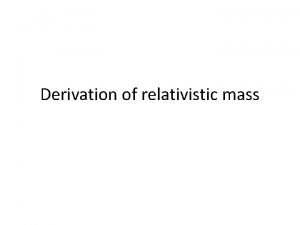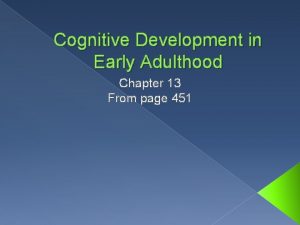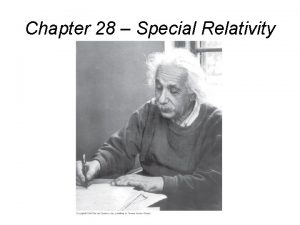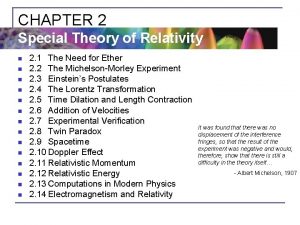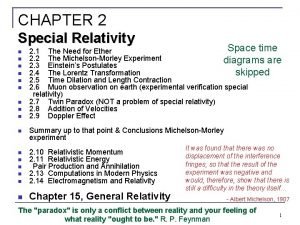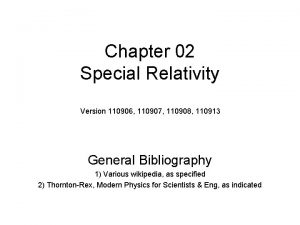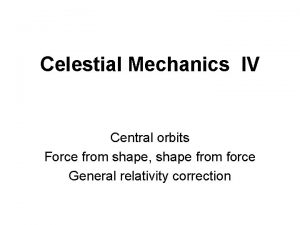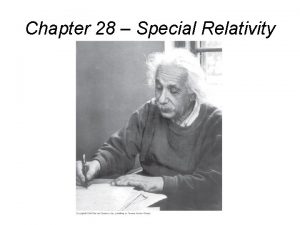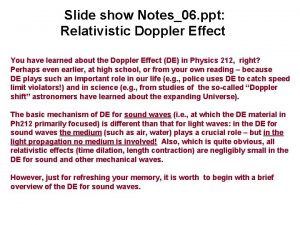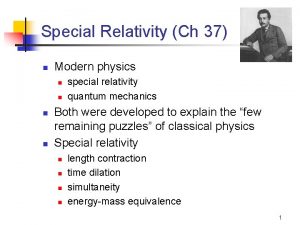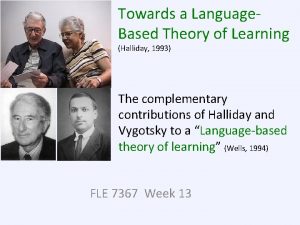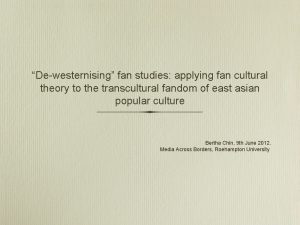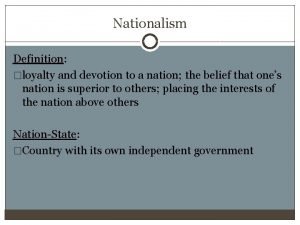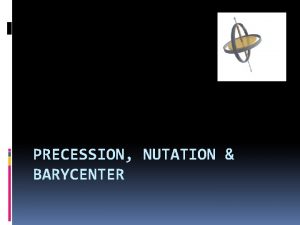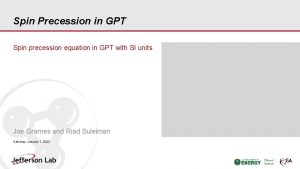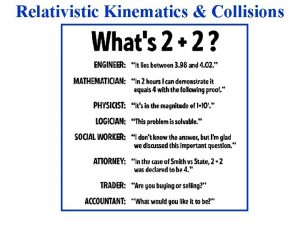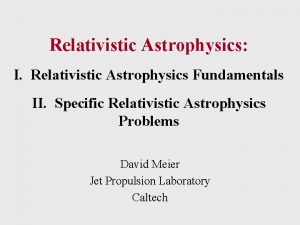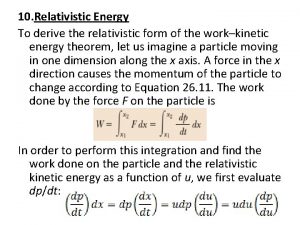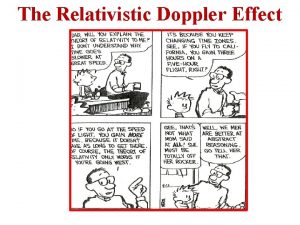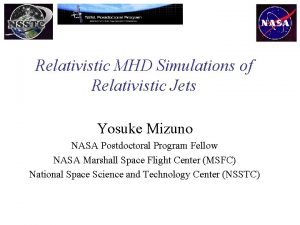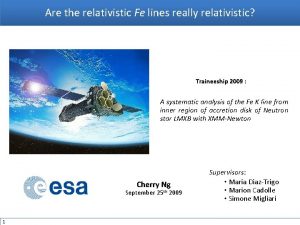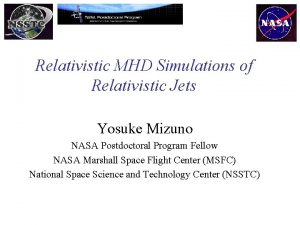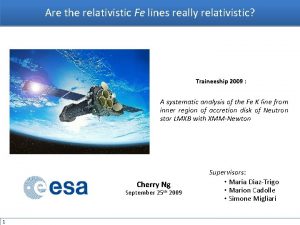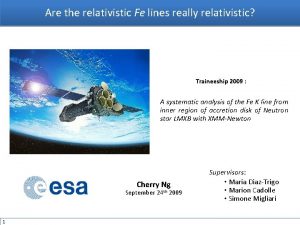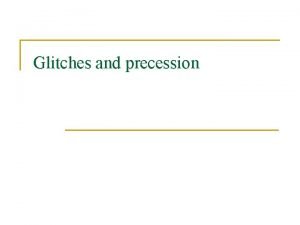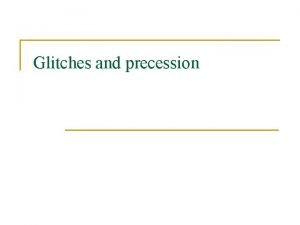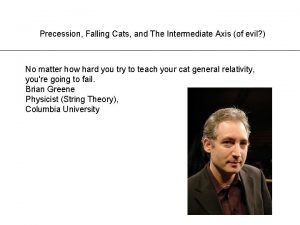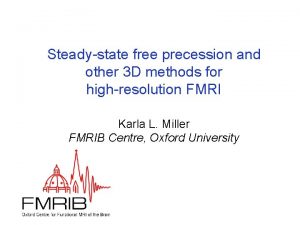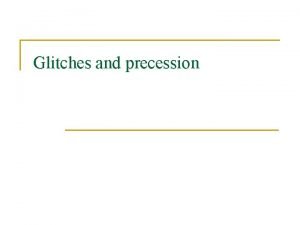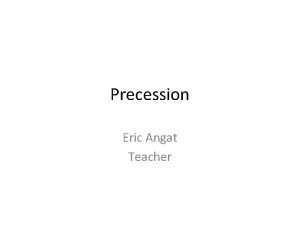Towards the relativistic theory of precession and nutation
























































- Slides: 56

Towards the relativistic theory of precession and nutation _ S. A. Klioner Lohrmann Observatory, Dresden Technical University Problems of Modern Astrometry, Moscow, 25 October 2007 1

Relativity and Earth rotation: why to bother? • Earth rotation is the only astronomical phenomenon - which is observed with a high accuracy and - which has no consistent relativistic model • Modern theories of precession/nutation (IAU 2000) are based on purely Newtonian theories with geodetic precession and nutation added in an inconsistent way • Modern theories of rigid Earth nutation are intended to attain formal accuracy of 1 as 2

Relativity and Earth rotation: one more reason • The main relativistic effects are significantly larger: • 0. 019 per year from geodetic precession (3 10 -4 of general precession) • 200 as from geodetic nutation • 1– 50 as from relativistic torques (different authors give different estimates) • Geodynamical observations give important tests of General Relativity The best estimates of the PPN using large range of angular distances from the Sun comes from geodetic VLBI data: (Eubanks, et al. 1998) 3

Main goal of the project • Derivation of a new consistent and improved precession/nutation series for a rigidly rotating multipole model of the Earth in the post-Newtonian approximation of general relativity • using post-Newtonian definitions of : - potential coefficients - moment of inertia tensor • dynamical equations in the GCRS • correct relativistic time scales • rigorous treatment of the geodetic precession and nutation 4

Relativistic post-Newtonian theory The Earth rotates, but relative to what? 5

Post-Newtonian theory: kinematics • Two answer are possible in relativity: the stellar compass 6 the inertial compass

In Newtonian physics this are only two ways to get to the same absolute space: M. C. Escher Cubic space division, 1952 7

Post-Newtonian theory: orientation of the BCRS • It is assumed that our global reference system, BCRS, does not rotate with respect to remote quasars. • This is a cosmological assumption to be verified by dynamical observations • This is also an idealization: source structure is not negligible 8

Post-Newtonian theory: orientation of the GCRS • IAU (1991): … the orientation of the reference systems be chosen so that it shows no rotation with respect to distant celestial objects… • No rotational matrix in the transformation between BCRS and GCRS • The GCRS is kinematically non-rotating with respect to the BCRS 9

Post-Newtonian theory: metric of the GCRS • The GCRS is kinematically non-rotating with respect to the BCRS produces Coriolis forces: relativistic precession 10

Post-Newtonian theory: relativistic precession • The GCRS is kinematically non-rotating with respect to the BCRS produces Coriolis forces: relativistic precession geodetic precession Lense-Thirring precession 11 Thomas precession

Relativistic precession: experimental status • Gravity Probe B the longest lasting experiment in modern history (1959 -2008? ) launched 20 April 2004 J (Earth) Geodetic prec. 6. 6 ’’/yr gyro IM Peg L (orbital) 42 mas/yr Francis Everitt Frame dragging No results yet… 12

Relativistic precession: experimental status • LLR: geodetic precession <1% (Newhall et al. , 1996; … ) • SLR: Lense-Thirring precession 2 -10% ? ? ? (Ciufolini, Pavlis, 2004) • VLBI & Earth rotation: geodetic precession 30% (Krasinsky, 2006) 13

Post-Newtonian equations of rotational motion - Post-Newtonian equations of rotational motion in the GCRS (Voinov, 1988; Damour, Soffel, Xu, 1993) - the angular momentum of the body reads is the energy-momentum tensor 14

Post-Newtonian equations of rotational motion - Post-Newtonian equations of rotational motion in the GCRS (Voinov, 1988; Damour, Soffel, Xu, 1993) - the torque - ML and SL are the Blanchet-Damour multipole moments of the body - GL and HL for l>2 are the gravitoelectric and gravitomagnetic tidal moments - simplification of the torque 15 can be neglected

Further simplifications of the torque - Mass dipole Ma vanishes in the GCRS - SL for l>1 can be neglected at the level of 0. 1 as 16

Further simplifications of the torque - All external bodies are assumed to be mass monopoles Newtonian term 17

Post-Newtonian equations of rotational motion - Post-Newtonian equations of rotational motion in the GCRS (Voinov, 1988; Damour, Soffel, Xu, 1993) - The gravitomagnetic tidal moment Ha defines the Coriolis forces: geodetic precession Lense-Thirring precession Thomas precession 18

Post-Newtonian angular velocity? • We have spin S a … • What is about angular velocity? ? ? 19

Newtonian physics: non-rigid body • One introduces some rigidly rotating reference system and the matrix is selected in such a way that the body can be considered “at rest on the average” in the rotating coordinates. 1. Principal axes of inertia one borrows the definition of the tensor of inertia from the rigid-body theory condition defines the angular velocity 20 and matrix

Newtonian physics: non-rigid body 2. Tisserand axes “angular momentum relative to the rotating coordinates” (no immediate physical meaning the same functional form as the conserved spin in inertial coordinates) condition defines the Tisserand axes and the corresponding taking the angular velocity 21 corresponding to that one has

Post-Newtonian Tisserand axes Both - restricted rigid body models of Thorne & Gürsel, 1983 - post-Newtonian Tisserand axes of Klioner, 1996 give the same equation: - the post-Newtonian tensor of inertia has a definition as an integral over the volume of the body - but that definition plays no role for practical work: exactly as multipole moments of the Earth, the numerical value of the tensor of inertia is determined from observations 22

Rigidly rotating multipoles • Klioner, Soffel, Xu, Wu, 2001 (based on many previous results): - Post-Newtonian equations of rotational motion in the GCRS - Rigidly rotating multipoles: several assumptions on the multipole moments and the tensor of inertia 23

STF approach to compute the torque 1. For any STF tensor: 2 l +1 real numbers STF basis 2. For the multipole moments of the Earth: equivalent to the 2 l +1 harmonic coefficients 3. For the tidal moments: functions of the ephemeris data 24

STF approach to compute the torque 2. For the multipole moments of the Earth: equivalent to the 2 l +1 harmonic coefficients with Clm and Slm defined from 25

STF approach to compute the torque numbers 4. The torque: 5. This is equivalent to the classical formulation with Legendre polynomials for Newtonian tidal potentials 26

STF approach to compute the torque 4. The torque: 27

Legendre polynomials vs. STF tensors for the Newtonian torque as 28 years from J 2000

Numerical integration • Fortran 95 code, about 15000 lines • careful coding to avoid • numerical instabilities and • excessive round-off errors • two numerical integrators: ODEX and ABM with dense output • automatic accuracy check: forth and back integrations • tuneable arithmetic: 64 bit, 80 bit, 128 bit (availability is hardware- and compiler-dependent) • FMlib: arbitrary-precision arithmetic for precision-critical operations • STF code was automatically generated by Mathematica • baseline: 80 bit on Intel architecture gives errors <0. 001 as for 150 years 29

Numerical integration • A number of relativistic issues are treated for the first time • fully post-Newtonian torques with STF machinery • rigorous treatment of geodetic precession/nutation • rigorous treatment of the time scales (TT vs. TDB) • correct relativistic scaling of constants and parameters (GM compatible with TT is NOT compatible with TDB!) • Performance of the code: • Newtonian torque with Legendre polynomials: • Newtonian torque with STF tensors: • Newtonian and geodetic torques: • post-Newtonian torque: 30 4. 0 sec per year 3. 3 sec per year 3. 5 sec per year 8. 2 sec per year

Definition of the Euler angles • Two main reference systems: xyz in the BCRS is defined by the ecliptic and the equinox J 2000: - terrestrial system: 31

Newtonian test bed: SMART 97 • Bretagnon, Rocher, Simon, Francou, 1996 -1997 • analytical theory of precession/nutation for rigid Earth • detailed comparisons with numerical integrations • Published series of SMART 97: formal accuracy of 2 as • Jean Louis Simon has provided the authors with the unpublished full version of SMART 97: about 70000 Poisson terms for each of the three angles formal accuracy 0. 01 as 32

Differences between our integration and SMART 97: 50 days as 33 years from J 2000

Differences between our integration and SMART 97: 55 years as 34 years from J 2000

Differences between our integration and SMART 97: 150 years as 35 years from J 2000

Comparison with Bretagnon’s results • Bretagnon, Francou, Rocher, Simon, 1997: SMART 97 -numerical integration JD 36

Effects of the post-Newtonian torque as 37 years from J 2000

Effects of the post-Newtonian torque as 38 years from J 2000

Effects of the post-Newtonian torque as 39 years from J 2000

Geodetic precession as a Coriolis torque 1. Geodetic precession is added to the torque: 2. Initial conditions of the numerical integration are changed to correct for the geodetic precession/nutation 3. The results are subtracted from the numerical solution corresponding to the dynamical version of SMART 97 4. 40 The published analytical solution for the geodetic precession/nutation was used to subtract the “known geodetic precession/nutation” from the result: 72 terms for 102 terms for 61 terms for The results show the errors in our current models for geodetical p/n

Geodetic precession as a Coriolis torque as 41 years from J 2000

Geodetic precession as a Coriolis torque detrended as 42 years from J 2000

Geodetic precession as a Coriolis torque as Known analytical solutions for geodetic precession/nutation are only valid if the kinematical and dynamical angles are defined with respect to the same plane in the BCRS. This is however not true in practice and gets basically the same geodetic precession/nutation terms as The approximate integral still holds: 43 .

Geodetic precession as a Coriolis torque It is NOT sufficient just to add the geodetic precession/nutation: The frequencies of the Newtonian solution must be also corrected for geodetic precession/nutation! as 44 years from J 2000

Next steps • Clarify the meaning of the initial conditions in the relativistic context: a mixture of dynamically and kinematically non-rotating GCRS is used in SMART 97 and IAU 2000 • The clarification of the initial conditions implies clear relativistic definitions of all involved planes and points, e. g. a clear relativistic definition of ecliptic or “image of the ecliptic” in the GCRS • Relativistically meaningful values of the constants (related to the first two): • the moments of inertia A, B, C • the longitude of the principal axes of inertia in the terrestrial system 45

Non-rigid Earth • Violate the assumptions of the model of rigidly rotating multipoles the one by one and check what is important • No way to proceed with the idea of “transfer functions” in relativity • Generalize the approach of “extended SOS theory” into the post-Newtonian approximation of general relativity (e. g. Krasinsky, 2006; Getino, et al. 1991 - 46 )

Backup slides 47

Newtonian physics: rigid body • Arbitrary motion of a rigid body with a fixed point is a rotation around that fixed point described by an orthogonal matrix Pij(t). Consequences: • Velocity distribution within a rigid body: • A reference system where the body is at rest: 48

Newtonian physics: rigid body • Total angular momentum (spin) of the body is defined as • Physical merit of this definition: for an isolated body • From the distribution of the velocity • 49 is the Newtonian tensor of inertia inside the body

Newtonian theory: equations of rotational motion • Newtonian equations of rotational motion read • L is a multi-index: 50 • are the multipole moments of the gravitational field of the body • are the moments of the external gravitational potential at the “geocenter”

Relativistic formulation - Post-Newtonian torque from “geodetic” precession - Post-Newtonian tidal moments from point masses • machinery of STF tensors • in the Newtonian limit equivalent to the Legendre polynomials 51

Relativistic formulation - Post-Newtonian tidal moments from point masses (some notations) 52

Why and are so similar? • For an axially symmetric “Earth” one has: For triaxial Earth: as per day 53 years from J 2000

Why and are so similar? • Numerical integration and SMART give very similar as per day 54 years from J 2000

Why and are so similar? • Numerical integration and SMART give very similar 55

Why and are so similar? detrended as 56 years from J 2000
 Nutation
Nutation Nutation
Nutation Relativistic mean field theory
Relativistic mean field theory Precession milankovitch cycles
Precession milankovitch cycles Electron spin animation
Electron spin animation Larmor frequency formula
Larmor frequency formula Planes fly in which layer
Planes fly in which layer Précession des équinoxes animation
Précession des équinoxes animation Proton precession magnetometer
Proton precession magnetometer Physical development in adulthood
Physical development in adulthood Relativistic circular motion
Relativistic circular motion Relativistic thinking example
Relativistic thinking example Relativistic mass
Relativistic mass Bertrand postulate
Bertrand postulate General relativity formula
General relativity formula Relativistic momentum
Relativistic momentum Relativistic thinking example
Relativistic thinking example Derivation of relativistic mass
Derivation of relativistic mass Cognitive-affective complexity
Cognitive-affective complexity Relativistic kinetic energy
Relativistic kinetic energy Relativistic kinetic energy
Relativistic kinetic energy Rest energy of a proton
Rest energy of a proton Relativistic kinetic energy
Relativistic kinetic energy Clairaut equation
Clairaut equation A physical education chapter 28
A physical education chapter 28 Doppler effect animation ppt
Doppler effect animation ppt Relativistic momentum
Relativistic momentum Halliday 1993
Halliday 1993 Fan culture theory
Fan culture theory Compare torvald and nora's attitude towards money
Compare torvald and nora's attitude towards money It is a devotion and loyalty to a nation
It is a devotion and loyalty to a nation Hát kết hợp bộ gõ cơ thể
Hát kết hợp bộ gõ cơ thể Ng-html
Ng-html Bổ thể
Bổ thể Tỉ lệ cơ thể trẻ em
Tỉ lệ cơ thể trẻ em Gấu đi như thế nào
Gấu đi như thế nào Chụp tư thế worms-breton
Chụp tư thế worms-breton Hát lên người ơi
Hát lên người ơi Môn thể thao bắt đầu bằng chữ f
Môn thể thao bắt đầu bằng chữ f Thế nào là hệ số cao nhất
Thế nào là hệ số cao nhất Các châu lục và đại dương trên thế giới
Các châu lục và đại dương trên thế giới Công thức tính độ biến thiên đông lượng
Công thức tính độ biến thiên đông lượng Trời xanh đây là của chúng ta thể thơ
Trời xanh đây là của chúng ta thể thơ Mật thư tọa độ 5x5
Mật thư tọa độ 5x5 Phép trừ bù
Phép trừ bù Phản ứng thế ankan
Phản ứng thế ankan Các châu lục và đại dương trên thế giới
Các châu lục và đại dương trên thế giới Thể thơ truyền thống
Thể thơ truyền thống Quá trình desamine hóa có thể tạo ra
Quá trình desamine hóa có thể tạo ra Một số thể thơ truyền thống
Một số thể thơ truyền thống Cái miệng nó xinh thế
Cái miệng nó xinh thế Vẽ hình chiếu vuông góc của vật thể sau
Vẽ hình chiếu vuông góc của vật thể sau Nguyên nhân của sự mỏi cơ sinh 8
Nguyên nhân của sự mỏi cơ sinh 8 đặc điểm cơ thể của người tối cổ
đặc điểm cơ thể của người tối cổ V cc
V cc Vẽ hình chiếu đứng bằng cạnh của vật thể
Vẽ hình chiếu đứng bằng cạnh của vật thể Tia chieu sa te
Tia chieu sa te

